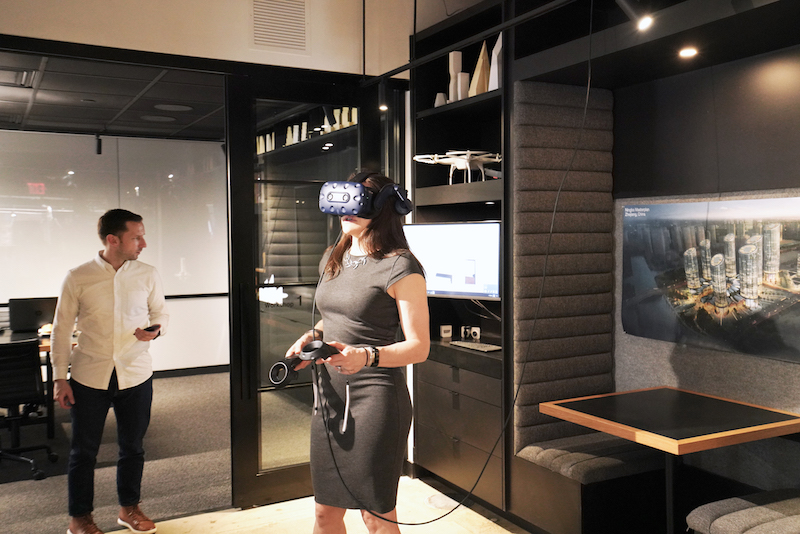Woods Bagot, one of the industry’s oldest architectural firms, is embracing the future of design and client relations with virtual reality apps that offer customizable interfaces.
For a number of years, the firm has played with a variety of virtual reality apps for design presentations, including ones that allow for 360-degree viewing.
About a year ago, Woods Bagot, with 16 studios around the world, developed its own VR app, driven by game-engine technology, with the goal being to give clients a unique spatial and human experience “that you can’t get from a rendering or even animation,” says Shane Burger, Woods Bagot’s Principal and Global Leader of Technical Innovation.
The “bespoke” app works like this: Woods Bagot creates what Burger calls a “white-card rendering” that puts the client in the VR space and allows him or her to move from room to room. The environment is designed, but in a very early concept stage.
The apps, so far at least, have been most effective for designing interiors, says Burger.
The beauty of using VR apps in early design stages is that there’s a fairly quick turnaround so that a more refined design can be presented to the client either in Woods Bagot’s New York office—which includes a 10x15-ft space equipped with an HTC Vive headset and screen—or by using a phone app with a portable headset like Google cardboard.
One of the benefits of having clients install the apps on their phones, explains Burger, is that they can receive Woods Bagot’s design proposals right away, and that multiple people can view the design simultaneously. (The designs are accessed via a web link.)
Woods Bagot has developed apps for both iOS and Android phones.
The first time the firm deployed a customizable VR app was to bid on a project with a technology client. Since then, Woods Bagot has made a number of refinements to its platform, such as adding more interfaces that allow clients to “walk through” multiple floors of the building. Woods Bagot is now developing apps that allow users to flip through white-card and materials environments within VR.
The biggest “learning step” in virtual design, says Burger, has been “to keep our options open, and to keep the user interface really simple, because most clients don’t have a lot of experience with VR.” Indeed, when Woods Bagot walks a client through the process, it typically has the user stay relatively stationary to get used to the VR surroundings.
Burger says most users are less disoriented when they use a mobile app because the viewer doesn’t block their peripheral vision.
VR is becoming a more sophisticated design tool for Woods Bagot, whose visualization team in London has been generating renderings right from virtual reality. Woods Bagot also recently used its VR app with a client for a project in Japan with 18 floors.
Woods Bagot is striving to get to the point where using a customized VR app enables a conversation with clients “that wouldn’t have happened otherwise,” says Burger.
Related Stories
Industrial Facilities | Apr 9, 2024
Confessions of a cold storage architect
Designing energy-efficient cold storage facilities that keep food safe and look beautiful takes special knowledge.
AEC Innovators | Feb 28, 2024
How Suffolk Construction identifies ConTech and PropTech startups for investment, adoption
Contractor giant Suffolk Construction has invested in 27 ConTech and PropTech companies since 2019 through its Suffolk Technologies venture capital firm. Parker Mundt, Suffolk Technologies’ Vice President–Platforms, recently spoke with Building Design+Construction about his company’s investment strategy.
MFPRO+ Special Reports | Feb 22, 2024
Crystal Lagoons: A deep dive into real estate's most extreme guest amenity
These year-round, manmade, crystal clear blue lagoons offer a groundbreaking technology with immense potential to redefine the concept of water amenities. However, navigating regulatory challenges and ensuring long-term sustainability are crucial to success with Crystal Lagoons.
AEC Tech | Feb 20, 2024
AI for construction: What kind of tool can artificial intelligence become for AEC teams?
Avoiding the hype and gathering good data are half the battle toward making artificial intelligence tools useful for performing design, operational, and jobsite tasks.
Building Tech | Feb 20, 2024
Construction method featuring LEGO-like bricks wins global innovation award
A new construction method featuring LEGO-like bricks made from a renewable composite material took first place for building innovations at the 2024 JEC Composites Innovation Awards in Paris, France.
Modular Building | Jan 19, 2024
Building with shipping containers not as eco-friendly as it seems
With millions of shipping containers lying empty at ports around the world, it may seem like repurposing them to construct buildings would be a clear environmental winner. The reality of building with shipping containers is complicated, though, and in many cases isn’t a net-positive for the environment, critics charge, according to a report by NPR's Chloe Veltman.
Sponsored | BD+C University Course | Jan 17, 2024
Waterproofing deep foundations for new construction
This continuing education course, by Walter P Moore's Amos Chan, P.E., BECxP, CxA+BE, covers design considerations for below-grade waterproofing for new construction, the types of below-grade systems available, and specific concerns associated with waterproofing deep foundations.
Mass Timber | Jan 2, 2024
5 ways mass timber will reshape the design of life sciences facilities
Here are five reasons why it has become increasingly evident that mass timber is ready to shape the future of laboratory spaces.
Sustainability | Nov 1, 2023
Researchers create building air leakage detection system using a camera in real time
Researchers at the U.S. Department of Energy’s Oak Ridge National Laboratory have developed a system that uses a camera to detect air leakage from buildings in real time.
Engineers | Oct 12, 2023
Building science: Considering steel sheet piles for semi-permanent or permanent subsurface water control for below-grade building spaces
For projects that do not include moisture-sensitive below-grade spaces, project teams sometimes rely on sheet piles alone for reduction of subsurface water. Experts from Simpson Gumpertz & Heger explore this sheet pile “water management wall” approach.
















